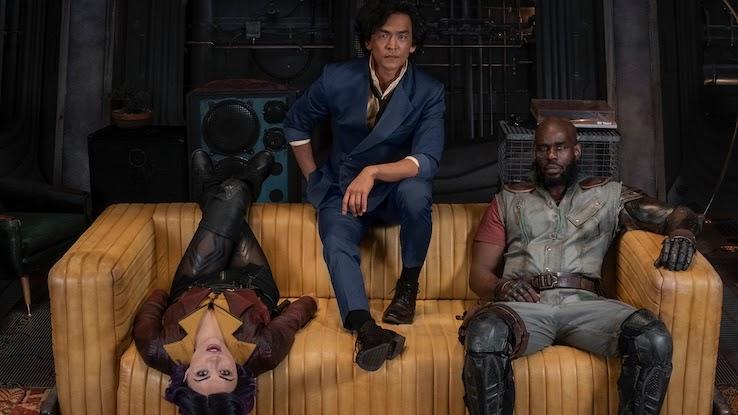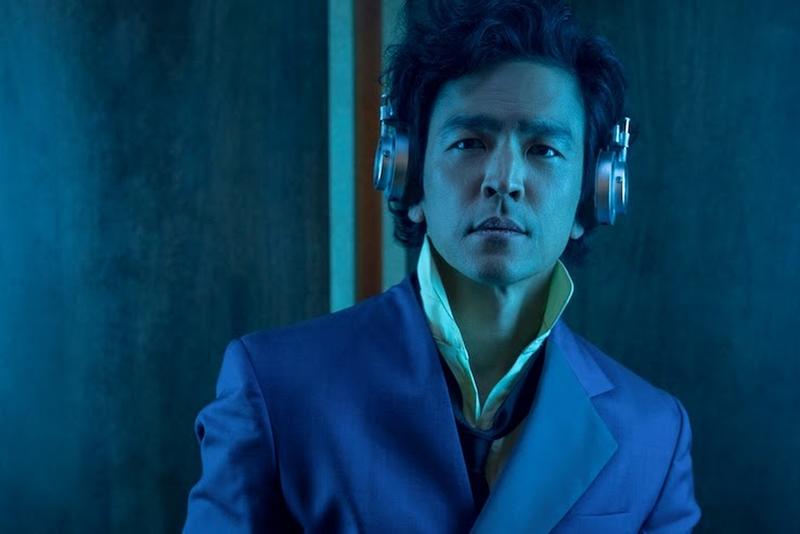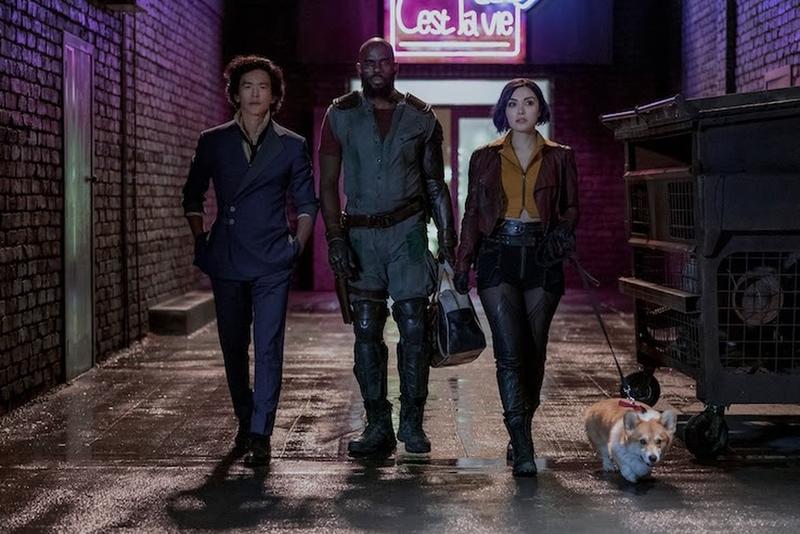
Rating: 7/10
I may have already mentioned that it doesn’t get any cooler — or sexier — than John Cho enveloped by a double-breasted indigo blue blazer, slim pants, white shirt with the collar up, headphones made-for-music-lovers on and, oh yeah, smoking.
The Star Trek alum exudes equal parts charisma, charm and cynicism as Spike Spiegel. He’s an intergalactic bounty hunter — a.k.a. cowboy — who’s partnered with the maligned ex-cop Jet Black (Mustafa Shakir) and trying to make a meager living by catching bad guys across the solar system. They are business partners and roommates aboard the Bebop — a ship made of salvaged parts that’s barely staying together, but that boasts an impressive jazz vinyl collection. They soon cross paths with Faye Valentine (Daniella Pineda), an impulsive and vivacious bounty hunter with a mild case of amnesia after a cryogenically induced nap that went wrong. The three characters and the whole live-action show are based on the original Japanese animated TV series of the same name. Cowboy Bebop premieres on Netflix on November 19.
If, like me, you’re new to Cowboy Bebop‘s world, you’ll need to get acquainted with this particular universe in which earning your keep and being middle class seems even harder than in current times; having a dog is a high-taxing activity, only affordable to the super-rich; and there’s a syndicate of villainous criminals co-led by the hot-tempered Vicious (Alex Hassell). But the 10-episode first season of the series has an uncomplicated way of not relying on exposition and letting the audience know new information about this singular universe and our lead’s backstories on a need-to-know basis that’s also engaging.
A Stylized Genre Mash-Up With Lots of Heart

The stylized, dynamic and colorful opening credits of Cowboy Bebop very much set the tone for what the show is: a genre-bending action-adventure space opera with a little bit of tragedy and more than a pinch of comedy thrown in. I found myself not clicking the “Skip Intro” button on Netflix while watching the show just because I liked how the music and visuals of the credits put me in the right mindset to enjoy Cowboy Bebop. You need to be a bit open-minded: you get a throwback to a campy and comedic 1960s action show here, an homage to jazz and noir films shot in sepia tones there, traces of Robert Rodriguez’s neo-westerns and perhaps too much of a generous dose of gore.
There’s a fair share of hand-to-hand combat too. Fighting scenes are perfectly choreographed and set to upbeat music. Spike masters the art of Jeet Kune Do, Bruce Lee‘s way of combining different fighting styles, with notes of Kung Fu and even fencing.
Cowboy Bebop excels at the formula of solving-one-case/chasing-one-criminal-with-a-high-bounty-on-their-head per episode. It reminded me of another recent Western-meets-space opera, The Mandalorian, but I felt the longer episodes of this show allow for the guest characters to get properly developed. Some of them have more charm than others. And all that bounty hunting business is intertwined with overarching stories that flesh out Faye, Jet and, especially, Spike’s backstories.
The Odd Trio and Cowboy Bebop’s Other Characters

Most case-of-the-episode shows are centered around the chemistry between the two leads. But Cowboy Bebop is a three-person affair. And the chemistry between Spike, Jet and Faye couldn’t be higher. Jet and Spike are like an old couple who’s forgotten to take care of the marriage. “I told you to lay off that Venusian tea. Stuff runs right through you,” Jet scolds Spike when he needs to go to the bathroom in the middle of a dangerous assignment. Theirs is a very codependent relationship where both parties hide things from each other.
When Faye shows up things get rebalanced. Jet has almost a sweet and paternal instinct toward the younger bounty hunter, and he’s very much the glue that holds this dysfunctional family together. Spike and Faye simply clash about the many things they have in common. But it’s particularly enjoyable to see them argue when Faye uses all the hot water on the Bebop after taking a shower-bath-shower — I’ll let her explain to you what that genius yet unecological invention is — or when she gives Spike advice on how to treat a migraine: “Do you know what you need? The big ‘O.’ Nature’s cure. I speak from experience, recent experience,” she suggests.
Then there’s Ein, the most adorable of Welsh corgis on TV right now. And there are a bunch of those every new season of The Crown. He can play dead on command and makes for a very cuddly tango partner. He’s also our protagonists’ furry companion.
What Cowboy Bebop gets right that other recent science fiction adaptations haven’t — besides being engrossing from the first episode and not taking itself too seriously — is a science fiction futuristic universe realistic enough to not fail to include LGBTQ+ representation. Not only is Faye unapologetically queer, but the show also cast nonbinary actor Mason Alexander Park to play Gren, the face at the door of the glamorous jazz club Anna’s that Spike frequents. Costume designer Jane Holland worked with Park in the design of non-gendered garments for Gren. They were influenced by David Bowie.
With frequent comments on class, privilege and the many difficulties of paying taxes and still earning enough woos (Cowboy Bebop‘s currency), and with production and costume designs reminiscent of the 1940s and 1950s but also, somehow, of present times, the show depicts a world that’s not unlike the one we live in today. The main differences are that people tend to dress better in Cowboy Bebop, they have impeccable taste in music, teletransport via hologram through thick cell phone devices, and can travel between planets.
The only reason why I didn’t like the show more is that toward the end of the season the recipe changed a bit and instead of the random bounty of the episode, we were increasingly confronted by cases relating to our protagonists’ pasts until the inevitable yet predictable necessity of dealing with Spike’s backstory halted everything else. And I feel the show just works better when it relies more on humor and the banter between its three main leads when they’re trying to catch baddies.






